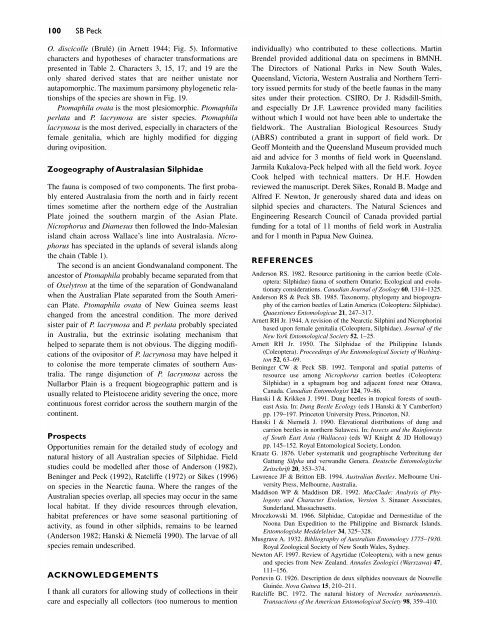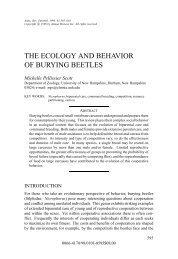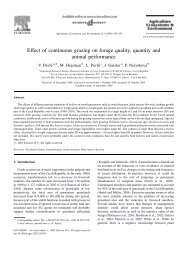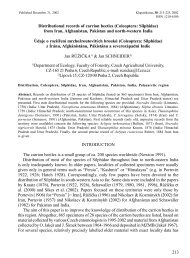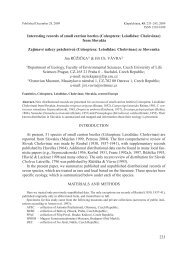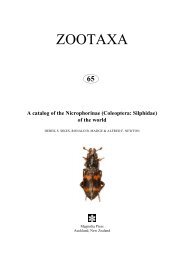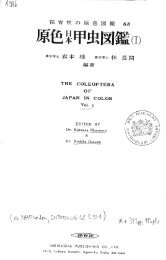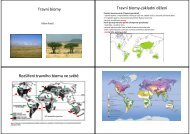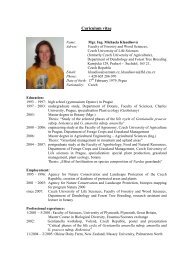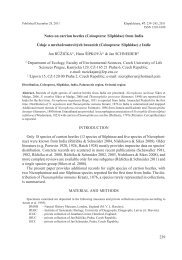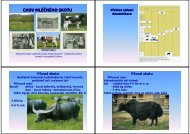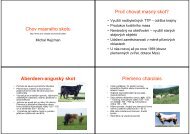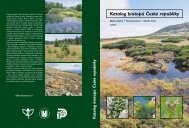Review of the carrion beetles of Australia and New Guinea ...
Review of the carrion beetles of Australia and New Guinea ...
Review of the carrion beetles of Australia and New Guinea ...
Create successful ePaper yourself
Turn your PDF publications into a flip-book with our unique Google optimized e-Paper software.
100 SB Peck<br />
O. discicolle (Brulé) (in Arnett 1944; Fig. 5). Informative<br />
characters <strong>and</strong> hypo<strong>the</strong>ses <strong>of</strong> character transformations are<br />
presented in Table 2. Characters 3, 15, 17, <strong>and</strong> 19 are <strong>the</strong><br />
only shared derived states that are nei<strong>the</strong>r unistate nor<br />
autapomorphic. The maximum parsimony phylogenetic relationships<br />
<strong>of</strong> <strong>the</strong> species are shown in Fig. 19.<br />
Ptomaphila ovata is <strong>the</strong> most plesiomorphic. Ptomaphila<br />
perlata <strong>and</strong> P. lacrymosa are sister species. Ptomaphila<br />
lacrymosa is <strong>the</strong> most derived, especially in characters <strong>of</strong> <strong>the</strong><br />
female genitalia, which are highly modified for digging<br />
during oviposition.<br />
Zoogeography <strong>of</strong> Australasian Silphidae<br />
The fauna is composed <strong>of</strong> two components. The first probably<br />
entered Australasia from <strong>the</strong> north <strong>and</strong> in fairly recent<br />
times sometime after <strong>the</strong> nor<strong>the</strong>rn edge <strong>of</strong> <strong>the</strong> <strong>Australia</strong>n<br />
Plate joined <strong>the</strong> sou<strong>the</strong>rn margin <strong>of</strong> <strong>the</strong> Asian Plate.<br />
Nicrophorus <strong>and</strong> Diamesus <strong>the</strong>n followed <strong>the</strong> Indo-Malesian<br />
isl<strong>and</strong> chain across Wallace’s line into Australasia. Nicrophorus<br />
has speciated in <strong>the</strong> upl<strong>and</strong>s <strong>of</strong> several isl<strong>and</strong>s along<br />
<strong>the</strong> chain (Table 1).<br />
The second is an ancient Gondwanal<strong>and</strong> component. The<br />
ancestor <strong>of</strong> Ptomaphila probably became separated from that<br />
<strong>of</strong> Oxelytron at <strong>the</strong> time <strong>of</strong> <strong>the</strong> separation <strong>of</strong> Gondwanal<strong>and</strong><br />
when <strong>the</strong> <strong>Australia</strong>n Plate separated from <strong>the</strong> South American<br />
Plate. Ptomaphila ovata <strong>of</strong> <strong>New</strong> <strong>Guinea</strong> seems least<br />
changed from <strong>the</strong> ancestral condition. The more derived<br />
sister pair <strong>of</strong> P. lacrymosa <strong>and</strong> P. perlata probably speciated<br />
in <strong>Australia</strong>, but <strong>the</strong> extrinsic isolating mechanism that<br />
helped to separate <strong>the</strong>m is not obvious. The digging modifications<br />
<strong>of</strong> <strong>the</strong> ovipositor <strong>of</strong> P. lacrymosa may have helped it<br />
to colonise <strong>the</strong> more temperate climates <strong>of</strong> sou<strong>the</strong>rn <strong>Australia</strong>.<br />
The range disjunction <strong>of</strong> P. lacrymosa across <strong>the</strong><br />
Nullarbor Plain is a frequent biogeographic pattern <strong>and</strong> is<br />
usually related to Pleistocene aridity severing <strong>the</strong> once, more<br />
continuous forest corridor across <strong>the</strong> sou<strong>the</strong>rn margin <strong>of</strong> <strong>the</strong><br />
continent.<br />
Prospects<br />
Opportunities remain for <strong>the</strong> detailed study <strong>of</strong> ecology <strong>and</strong><br />
natural history <strong>of</strong> all <strong>Australia</strong>n species <strong>of</strong> Silphidae. Field<br />
studies could be modelled after those <strong>of</strong> Anderson (1982),<br />
Beninger <strong>and</strong> Peck (1992), Ratcliffe (1972) or Sikes (1996)<br />
on species in <strong>the</strong> Nearctic fauna. Where <strong>the</strong> ranges <strong>of</strong> <strong>the</strong><br />
<strong>Australia</strong>n species overlap, all species may occur in <strong>the</strong> same<br />
local habitat. If <strong>the</strong>y divide resources through elevation,<br />
habitat preferences or have some seasonal partitioning <strong>of</strong><br />
activity, as found in o<strong>the</strong>r silphids, remains to be learned<br />
(Anderson 1982; Hanski & Niemelä 1990). The larvae <strong>of</strong> all<br />
species remain undescribed.<br />
ACKNOWLEDGEMENTS<br />
I thank all curators for allowing study <strong>of</strong> collections in <strong>the</strong>ir<br />
care <strong>and</strong> especially all collectors (too numerous to mention<br />
individually) who contributed to <strong>the</strong>se collections. Martin<br />
Brendel provided additional data on specimens in BMNH.<br />
The Directors <strong>of</strong> National Parks in <strong>New</strong> South Wales,<br />
Queensl<strong>and</strong>, Victoria, Western <strong>Australia</strong> <strong>and</strong> Nor<strong>the</strong>rn Territory<br />
issued permits for study <strong>of</strong> <strong>the</strong> beetle faunas in <strong>the</strong> many<br />
sites under <strong>the</strong>ir protection. CSIRO, Dr J. Ridsdill-Smith,<br />
<strong>and</strong> especially Dr J.F. Lawrence provided many facilities<br />
without which I would not have been able to undertake <strong>the</strong><br />
fieldwork. The <strong>Australia</strong>n Biological Resources Study<br />
(ABRS) contributed a grant in support <strong>of</strong> field work. Dr<br />
Ge<strong>of</strong>f Monteith <strong>and</strong> <strong>the</strong> Queensl<strong>and</strong> Museum provided much<br />
aid <strong>and</strong> advice for 3 months <strong>of</strong> field work in Queensl<strong>and</strong>.<br />
Jarmila Kukalova-Peck helped with all <strong>the</strong> field work. Joyce<br />
Cook helped with technical matters. Dr H.F. Howden<br />
reviewed <strong>the</strong> manuscript. Derek Sikes, Ronald B. Madge <strong>and</strong><br />
Alfred F. <strong>New</strong>ton, Jr generously shared data <strong>and</strong> ideas on<br />
silphid species <strong>and</strong> characters. The Natural Sciences <strong>and</strong><br />
Engineering Research Council <strong>of</strong> Canada provided partial<br />
funding for a total <strong>of</strong> 11 months <strong>of</strong> field work in <strong>Australia</strong><br />
<strong>and</strong> for 1 month in Papua <strong>New</strong> <strong>Guinea</strong>.<br />
REFERENCES<br />
Anderson RS. 1982. Resource partitioning in <strong>the</strong> <strong>carrion</strong> beetle (Coleoptera:<br />
Silphidae) fauna <strong>of</strong> sou<strong>the</strong>rn Ontario; Ecological <strong>and</strong> evolutionary<br />
considerations. Canadian Journal <strong>of</strong> Zoology 60, 1314–1325.<br />
Anderson RS & Peck SB. 1985. Taxonomy, phylogeny <strong>and</strong> biogeography<br />
<strong>of</strong> <strong>the</strong> <strong>carrion</strong> <strong>beetles</strong> <strong>of</strong> Latin America (Coleoptera: Silphidae).<br />
Quaestiones Entomologicae 21, 247–317.<br />
Arnett RH Jr. 1944. A revision <strong>of</strong> <strong>the</strong> Nearctic Silphini <strong>and</strong> Nicrophorini<br />
based upon female genitalia (Coleoptera, Silphidae). Journal <strong>of</strong> <strong>the</strong><br />
<strong>New</strong> York Entomological Society 52, 1–25.<br />
Arnett RH Jr. 1950. The Silphidae <strong>of</strong> <strong>the</strong> Philippine Isl<strong>and</strong>s<br />
(Coleoptera). Proceedings <strong>of</strong> <strong>the</strong> Entomological Society <strong>of</strong> Washington<br />
52, 63–69.<br />
Beninger CW & Peck SB. 1992. Temporal <strong>and</strong> spatial patterns <strong>of</strong><br />
resource use among Nicrophorus <strong>carrion</strong> <strong>beetles</strong> (Coleoptera:<br />
Silphidae) in a sphagnum bog <strong>and</strong> adjacent forest near Ottawa,<br />
Canada. Canadian Entomologist 124, 79–86.<br />
Hanski I & Krikken J. 1991. Dung <strong>beetles</strong> in tropical forests <strong>of</strong> sou<strong>the</strong>ast<br />
Asia. In: Dung Beetle Ecology (eds I Hanski & Y Camberfort)<br />
pp. 179–197. Princeton University Press, Princeton, NJ.<br />
Hanski I & Niemelä J. 1990. Elevational distributions <strong>of</strong> dung <strong>and</strong><br />
<strong>carrion</strong> <strong>beetles</strong> in nor<strong>the</strong>rn Sulawesi. In: Insects <strong>and</strong> <strong>the</strong> Rainforests<br />
<strong>of</strong> South East Asia (Wallacea) (eds WJ Knight & JD Holloway)<br />
pp. 145–152. Royal Entomological Society, London.<br />
Kraatz G. 1876. Ueber systematik und geographische Verbreitung der<br />
Gattung Silpha und verw<strong>and</strong>te Genera. Deutsche Entomologische<br />
Zeitschrift 20, 353–374.<br />
Lawrence JF & Britton EB. 1994. <strong>Australia</strong>n Beetles. Melbourne University<br />
Press, Melbourne, <strong>Australia</strong>.<br />
Maddison WP & Maddison DR. 1992. MacClade: Analysis <strong>of</strong> Phylogeny<br />
<strong>and</strong> Character Evolution, Version 3. Sinauer Associates,<br />
Sunderl<strong>and</strong>, Massachusetts.<br />
Mroczkowski M. 1966. Silphidae, Catopidae <strong>and</strong> Dermestidae <strong>of</strong> <strong>the</strong><br />
Noona Dan Expedition to <strong>the</strong> Philippine <strong>and</strong> Bismarck Isl<strong>and</strong>s.<br />
Entomologiske Meddelelser 34, 325–328.<br />
Musgrave A. 1932. Bibliography <strong>of</strong> <strong>Australia</strong>n Entomology 1775–1930.<br />
Royal Zoological Society <strong>of</strong> <strong>New</strong> South Wales, Sydney.<br />
<strong>New</strong>ton AF. 1997. <strong>Review</strong> <strong>of</strong> Agyrtidae (Coleoptera), with a new genus<br />
<strong>and</strong> species from <strong>New</strong> Zeal<strong>and</strong>. Annales Zoologici (Warszawa) 47,<br />
111–156.<br />
Portevin G. 1926. Description de deux silphides nouveaux de Nouvelle<br />
Guinée. Nova <strong>Guinea</strong> 15, 210–211.<br />
Ratcliffe BC. 1972. The natural history <strong>of</strong> Necrodes surinamensis.<br />
Transactions <strong>of</strong> <strong>the</strong> American Entomological Society 98, 359–410.


